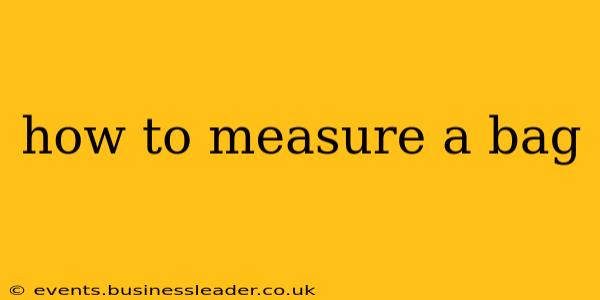Measuring a bag accurately is crucial for various reasons, from ensuring it fits in an airline's overhead compartment to making sure it's the right size for your needs. Whether you're shopping online, checking airline baggage allowances, or simply organizing your belongings, knowing how to measure a bag properly is essential. This guide covers different methods and considerations for accurate bag measurements.
What are the standard measurements for bags?
Standard bag measurements typically involve three dimensions: length, width, and height. Length is usually the longest dimension when the bag is lying flat, width is the shortest, and height is the measurement from the bottom to the top. However, some manufacturers might use slightly different definitions, so it's always best to check their specifications. These measurements are usually given in inches or centimeters.
How do I measure a bag's length, width, and height?
Measuring a bag accurately requires a flexible measuring tape and a little patience. Follow these steps:
-
Lay the bag flat: Place the bag on a flat, level surface. Ensure it's not crumpled or distorted.
-
Measure the length: Extend the measuring tape along the longest side of the bag. This measurement is usually taken from the base of the bag along the bottom. Note this measurement down.
-
Measure the width: Measure the shortest side of the bag. This is typically the measurement from one side of the bag to the other, excluding handles and straps. Record this dimension.
-
Measure the height: Measure the height from the base of the bag to its highest point, ensuring the measuring tape is vertical and straight. Consider external pockets or features that may add to the overall height. Document this final measurement.
-
Record your measurements: Write down all three measurements (length, width, height) clearly, noting the units used (inches or centimeters).
What tools do I need to measure a bag?
You'll primarily need a flexible measuring tape. A fabric tape measure is ideal, as it's less likely to damage the bag's material. For irregularly shaped bags, you might find a soft ruler or even a piece of string helpful (which you can then measure against a standard ruler).
How to measure a soft-sided bag versus a hard-sided bag?
Measuring a soft-sided bag is generally straightforward, following the steps outlined above. However, remember that soft-sided bags can be compressed or expanded, so the measurements might vary slightly depending on how full the bag is. It's best to measure the bag when it's roughly the same fullness you anticipate for its typical use.
Hard-sided bags are easier to measure because they maintain their shape. The measurements will be more consistent regardless of how full the bag is.
How to measure a backpack?
Measuring a backpack uses the same principles as other bags, but you need to consider the specific features:
-
Length: Measure along the base of the backpack, excluding any additional pockets.
-
Width: Measure the width at the widest point, including any side pockets.
-
Height: Measure the height from the base to the top of the backpack.
It’s particularly important to measure the height accurately for checking airline carry-on size restrictions.
What if my bag is an unusual shape?
For oddly shaped bags, you might need to take multiple measurements at different points to get a better understanding of its dimensions. You might need to describe the shape more qualitatively in addition to providing numerical measurements. Consider using photographs to supplement your measurements.
By following these steps and considering the bag's characteristics, you can accurately measure any bag for a variety of purposes. Remember to always double-check your measurements before making important decisions based on them.
